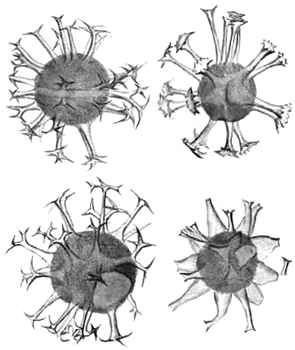Main Page
 |
DINOFLAJ3 |
 |
| SEM image of Spiniferella cornuta provided by Sarah Damassa. | Species illustrated by Ehrenberg, 1837b as Xanthidium. Upper and lower left: "Xanthidium ramosum" (now Spiniferites ramosus); upper right: "Xanthidium tubiferum" (now Hystrichosphaeridium tubiferum); lower right: "Xanthidium bulbosum" (now Hystrichokolpoma bulbosum). |
Update: Dinoflaj3!
01/2017: Taxonomic content is now updated. These introductory pages are in the process of being revised, now mostly completed.
Jan. 5: Final (?) Index and References version loaded. Introductory pages mostly assembled, now correcting errors.
WHAT IS DINOFLAJ3?
DINOFLAJ3 is a database system containing:
- An index of fossil dinoflagellates at generic, specific and infraspecific ranks. This information in DINOFLAJ3 is based on the latest edition of the Lentin and Williams Index (Williams et al., 2017). For a detailed description of the nomenclatural approach and format of DINOFLAJ3, refer to the Introduction.
- The classification of fossil and living dinoflagellates down to generic rank, where it is continuous where possible with the Index information. The classification is based on Fensome et al. (1993b), but has not been updated for the present version.
- Other information and illustrations on fossil dinoflagellates as appropriate and available, including full reference information updated from the above sources and a glossary of terms.
Information is hyperlinked for convenient browsing.
DINOFLAJ3 supersedes DINOFLAJ2 (Fensome et al., 2008), which in turn superseded DINOFLAJ v.1 (Fensome et al., 1998d; Geological Survey of Canada Open File 3653). Information will be updated periodically in the form of new formal versions of DINOFLAJ. In order to avoid confusion, it is recommended that the version always be indicated when citing DINOFLAJ. Past versions will be archived and kept available.
For nomenclatural purposes, a complete electronic document is provided with fixed pagination and content. Either the document or website should be cited as:
Williams, G.L., Fensome, R.A., and MacRae, R.A., 2017. The Lentin and Williams Index of Fossil Dinoflagellates, 2017 Edition. American Association of Stratigraphic Palynologists, Contributions Series Number 48, 1096p. ISSN 0160-8843. Website: http://dinoflaj.smu.ca/dinoflaj3
The authors wish to acknowledge the support of the Geological Survey of Canada, Saint Mary's University, and AASP &emdash; The Palynological Society, and the American Association of Stratigraphic Palynologists Foundation.
WHAT ARE DINOFLAGELLATES?
Dinoflagellates are single-celled organisms that have two distinctive flagella during at least part of their life cycle and/or a special type of nucleus called a dinokaryon (Fensome et al., 1993b). They are probably best known as a principal cause of "red tides" and paralytic shellfish poisoning. Some groups produce resistant organic-walled, calcareous or (rarely) siliceous cysts that are preserved in Mesozoic and Cenozoic sediments and sedimentary rocks. These fossils are useful in helping to determine ages of rocks (e.g. in understanding petroleum systems) and in understanding past environments (e.g. global change studies). For more information, see the Introduction.
MORE INFORMATION
CALL FOR DRAWINGS
DINOFLAJ3 currently contains simplified line drawings for over 900 generic, specific, and infraspecific entries. There are about 2200 "current" taxa (i.e. names currently in use in the literature). If you would like to contribute any drawings in digital form for your favourite taxon, read this formatting guide and contact us.